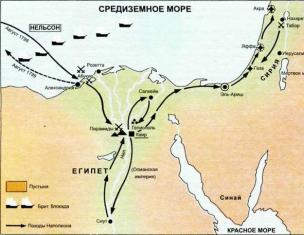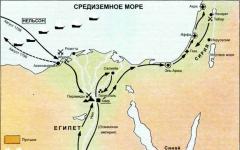1. ATOMIC BOMB: COMPOSITION, COMBAT CHARACTERISTICS AND PURPOSE OF CREATION
Before you start studying the structure of an atomic bomb, you need to understand the terminology on this problem. So, in scientific circles, there are special terms that reflect the characteristics of atomic weapons. Among them, we especially note the following:
Atomic bomb is the original name of an aircraft nuclear bomb, the action of which is based on an explosive chain nuclear fission reaction. With the advent of the so-called hydrogen bomb, based on the thermonuclear fusion reaction, a common term for them was established - a nuclear bomb.
Nuclear bomb - an aircraft bomb with a nuclear charge, has a large destructive force. The first two nuclear bombs, with a TNT equivalent of about 20 kt each, were dropped by American aircraft on the Japanese cities of Hiroshima and Nagasaki, respectively, on August 6 and 9, 1945, and caused enormous casualties and destruction. Modern nuclear bombs have a TNT equivalent of tens to millions of tons.
Nuclear or atomic weapons are explosive weapons based on the use of nuclear energy released during a nuclear chain reaction of the fission of heavy nuclei or a thermonuclear fusion reaction of light nuclei.
Refers to weapons of mass destruction (WMD) along with biological and chemical ones.
Nuclear weapons are a set of nuclear weapons, means of delivering them to the target and control means. Refers to weapons of mass destruction; has enormous destructive power. For the above reason, the USA and the USSR invested huge amounts of money in the development of nuclear weapons. Based on the power of charges and range, nuclear weapons are divided into tactical, operational-tactical and strategic. The use of nuclear weapons in war is disastrous for all humanity.
A nuclear explosion is a process of instantaneous release large quantity intranuclear energy in a limited volume.
The action of atomic weapons is based on the fission reaction of heavy nuclei (uranium-235, plutonium-239 and, in in some cases, uranium-233).
Uranium-235 is used in nuclear weapons because, unlike the most common isotope uranium-238, a self-sustaining nuclear chain reaction is possible in it.
Plutonium-239 is also called " weapons-grade plutonium", because it is intended for the creation of nuclear weapons and the content of the 239Pu isotope must be at least 93.5%.
To reflect the structure and composition of an atomic bomb, as a prototype we will analyze the plutonium bomb “Fat Man” (Fig. 1) dropped on August 9, 1945 on the Japanese city of Nagasaki.
atomic nuclear bomb explosion
Figure 1 - Atomic bomb "Fat Man"
The layout of this bomb (typical of plutonium single-phase munitions) is approximately as follows:
Neutron initiator - a ball with a diameter of about 2 cm made of beryllium, coated with a thin layer of yttrium-polonium alloy or metal polonium-210 - the primary source of neutrons for sharp reduction critical mass and accelerating the onset of the reaction. It is triggered at the moment the combat core is transferred to a supercritical state (during compression, polonium and beryllium are mixed with the release of a large number of neutrons). Currently, in addition to this type of initiation, thermonuclear initiation (TI) is more common. Thermonuclear initiator (TI). It is located in the center of the charge (like a NI) where a small amount of thermonuclear material is located, the center of which is heated by a converging shock wave and during the thermonuclear reaction, against the background of the resulting temperatures, a significant number of neutrons are produced, sufficient for the neutron initiation of a chain reaction (Fig. 2).
Plutonium. The purest isotope plutonium-239 is used, although to increase stability physical properties(density) and improve charge compressibility, plutonium is doped with a small amount of gallium.
A shell (usually made of uranium) that serves as a neutron reflector.
Aluminum compression shell. Provides greater uniformity of compression by the shock wave, while at the same time protecting the internal parts of the charge from direct contact with the explosive and the hot products of its decomposition.
Explosive with complex system detonation, ensuring synchronicity of detonation of everything explosive. Synchronicity is necessary to create a strictly spherical compressive (directed into the ball) shock wave. A non-spherical wave leads to the ejection of ball material through heterogeneity and the impossibility of creating a critical mass. The creation of such a system for the placement of explosives and detonation was at one time one of the most difficult tasks. A combined scheme (lens system) of “fast” and “slow” explosives is used.
The body is made of stamped duralumin elements - two spherical covers and a belt, connected by bolts.
Figure 2 - Operating principle of a plutonium bomb
The center of a nuclear explosion is the point at which the flash occurs or the center is located fireball, and the epicenter is the projection of the center of the explosion onto the earth or water surface.
Nuclear weapons are the most powerful and dangerous looking weapons of mass destruction, threatening all of humanity with unprecedented destruction and the extermination of millions of people.
If an explosion occurs on the ground or quite close to its surface, then part of the explosion energy is transferred to the Earth's surface in the form of seismic vibrations. A phenomenon occurs that resembles an earthquake in its characteristics. As a result of such an explosion, seismic waves, which spread through the thickness of the earth over very long distances. The destructive effect of the wave is limited to a radius of several hundred meters.
As a result of the extremely high temperature of the explosion, a bright flash of light is created, the intensity of which is hundreds of times greater than the intensity of sunlight falling on the Earth. A flash produces a huge amount of heat and light. Light radiation causes spontaneous combustion of flammable materials and skin burns in people within a radius of many kilometers.
At nuclear explosion radiation occurs. It lasts about a minute and has such a high penetrating power that powerful and reliable shelters are required to protect against it at close ranges.
A nuclear explosion can instantly destroy or disable unprotected people, openly standing equipment, structures and various material assets. The main damaging factors of a nuclear explosion (NFE) are:
shock wave;
light radiation;
penetrating radiation;
radioactive contamination of the area;
electromagnetic pulse (EMP).
During a nuclear explosion in the atmosphere, the distribution of released energy between PFYVs is approximately the following: about 50% for the shock wave, 35% for light radiation, 10% for radioactive contamination and 5% for penetrating radiation and EMR.
Radioactive contamination of people, military equipment, terrain and various objects during a nuclear explosion is caused by fission fragments of the charge substance (Pu-239, U-235) and the unreacted part of the charge falling out of the explosion cloud, as well as radioactive isotopes, formed in soil and other materials under the influence of neutrons - induced activity. Over time, the activity of fission fragments decreases rapidly, especially in the first hours after the explosion. For example, the total activity of fission fragments during the explosion of a nuclear weapon with a power of 20 kT after one day will be several thousand times less than one minute after the explosion.
Analysis of the effectiveness of the integrated application of noise protection measures to increase the stability of the functioning of communications equipment in conditions of enemy radio countermeasures
Considering the level technical equipment, an analysis of electronic warfare forces and assets will be carried out for the reconnaissance and electronic warfare battalion (R and EW) of the mechanized division (md) of the Army. The reconnaissance and electronic warfare battalion of the US Department of Defense includes)







